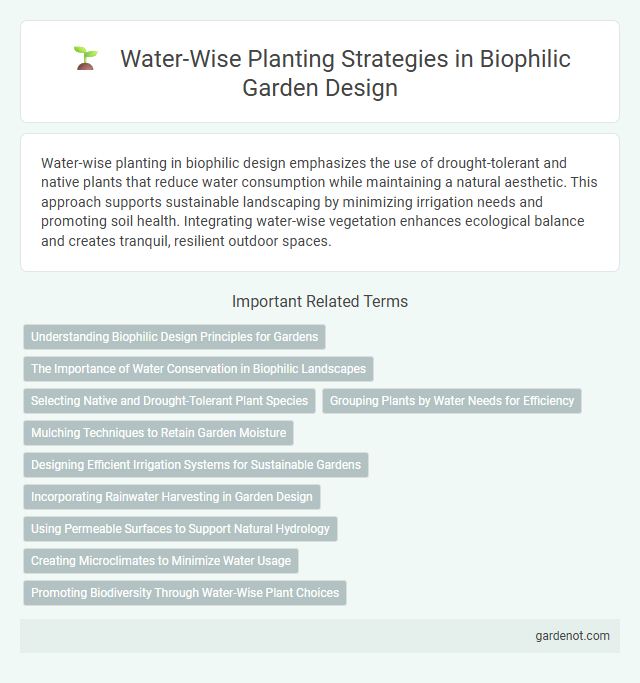Water-wise planting in biophilic design emphasizes the use of drought-tolerant and native plants that reduce water consumption while maintaining a natural aesthetic. This approach supports sustainable landscaping by minimizing irrigation needs and promoting soil health. Integrating water-wise vegetation enhances ecological balance and creates tranquil, resilient outdoor spaces.
Understanding Biophilic Design Principles for Gardens
Water-wise planting in biophilic design emphasizes using native and drought-tolerant species that enhance biodiversity while conserving water resources. Incorporating plants with varying textures, colors, and seasonal interest creates a multisensory garden environment that strengthens the human-nature connection. Strategic placement of water-efficient vegetation reduces irrigation needs and supports sustainable landscape health aligned with biophilic principles.
The Importance of Water Conservation in Biophilic Landscapes
Water-wise planting is essential in biophilic design to promote sustainable landscapes that conserve valuable water resources while supporting natural ecosystems. Implementing drought-tolerant species and native plants reduces irrigation needs, enhances soil health, and fosters biodiversity crucial for resilient outdoor environments. Efficient water management in biophilic landscapes mitigates the impacts of climate change and preserves potable water supplies for future generations.
Selecting Native and Drought-Tolerant Plant Species
Selecting native and drought-tolerant plant species in biophilic design significantly reduces water consumption while supporting local ecosystems. These plants are adapted to regional climate conditions, requiring minimal irrigation and maintenance. Incorporating such vegetation enhances landscape sustainability and promotes biodiversity within urban environments.
Grouping Plants by Water Needs for Efficiency
Water-wise planting maximizes irrigation efficiency by grouping plants with similar water requirements, reducing water waste and promoting healthier growth. This strategy supports sustainable landscaping in biophilic design by conserving water while maintaining vibrant, diverse plantings. Implementing hydro-zoning techniques ensures each plant receives optimal hydration aligned with its specific needs.
Mulching Techniques to Retain Garden Moisture
Mulching techniques enhance water-wise planting by reducing soil evaporation and maintaining consistent garden moisture levels. Organic mulches like bark, straw, and compost improve soil structure while conserving water and suppressing weeds. Effective mulch application supports sustainable landscaping practices central to biophilic design by promoting healthy plant growth with minimal water use.
Designing Efficient Irrigation Systems for Sustainable Gardens
Water-wise planting emphasizes selecting drought-tolerant and native species to minimize water consumption in sustainable gardens. Designing efficient irrigation systems involves using drip irrigation, smart sensors, and rainwater harvesting to optimize water distribution and reduce waste. These strategies promote ecosystem health while conserving resources in biophilic landscapes.
Incorporating Rainwater Harvesting in Garden Design
Incorporating rainwater harvesting in garden design enhances water-wise planting by capturing and utilizing natural rainfall, reducing reliance on municipal water sources. Strategic placement of rain barrels and permeable surfaces directs collected water to drought-tolerant plants, promoting sustainability and resilience in urban landscapes. This eco-friendly approach not only conserves water but also supports the health of native vegetation through efficient irrigation practices.
Using Permeable Surfaces to Support Natural Hydrology
Water-wise planting enhances biophilic design by integrating permeable surfaces such as gravel, porous concrete, and permeable pavers that facilitate natural water infiltration and reduce runoff. These surfaces support urban hydrology by allowing rainwater to percolate through the soil, promoting groundwater recharge and reducing strain on stormwater systems. Implementing permeable materials improves plant health and biodiversity by maintaining optimal moisture levels in sustainable, water-efficient landscapes.
Creating Microclimates to Minimize Water Usage
Water-wise planting in biophilic design utilizes drought-tolerant species to create microclimates that reduce evapotranspiration and conserve soil moisture. Strategic placement of vegetation provides natural shading and windbreaks, lowering ambient temperatures and minimizing water loss. These microclimates enhance sustainability by optimizing water use efficiency in landscapes with limited resources.
Promoting Biodiversity Through Water-Wise Plant Choices
Selecting native, drought-tolerant plants in water-wise landscaping supports local ecosystems by providing essential habitats and food sources for pollinators and wildlife. These species require less irrigation, conserving water resources while sustaining biodiversity in urban and residential environments. Incorporating varied plant heights, bloom times, and textures enhances habitat complexity, promoting a resilient and thriving ecosystem.
Water-wise planting Infographic

 gardenot.com
gardenot.com